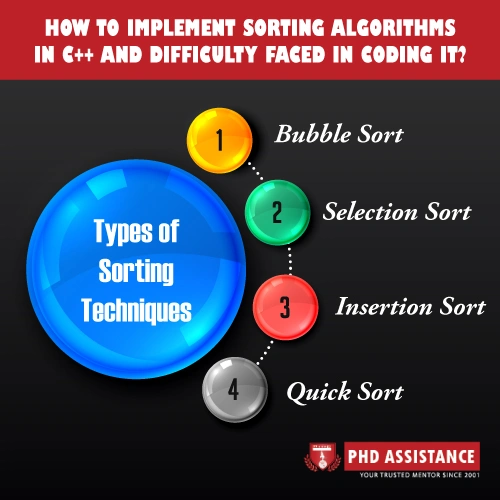How to implement sorting algorithms in C++ and difficulty faced in coding it?
Sorting algorithms are frequently utilized in computer science; they assist in putting elements in a logical order and can assist with a variety of issues encountered when developing code. Sorting algorithms assist us in manipulating data, making things easier for us. Sorting is an essential Algorithm in Computer Science because it may frequently minimize the complexity of a task. These techniques have real world applications in search algorithms, database algorithms, data structure algorithms, divide-and-conquer techniques, and a variety of other areas.
Sorting is a term used in C++ to rearrange the items of an array in a logical sequence [1]. The array can be arranged in any way, from lowest to highest, or from highest to lowest. Many issues may be solved by sorting an unsorted array, such as finding the smallest or largest element, and so on. Sorting objects makes things simpler to evaluate and find a certain aspect amid a large number of them. In the example below, users are sorting or organizing the members of an array format in ascending order, that is, from lowest to the highest. PhD Assistance experts has experience in handling dissertation and assignment in computer science research with assured 2:1 distinction. Talk to Experts Now
It’s the time it takes for a certain code or algorithm to analyze or execute as a consequence of the quantity of data it receives [2]. To put it another way, time complexity is simply efficiency, or the length of time it takes for a computer function to handle a given input. Seems to be the memory usage required for the algorithm to operate and generate the output (including the algorithm’s input values).
Internal sorting and external sorting are the two forms of sorting available. The data to be sorted is stored in the main memory or RAM, and the sorting process takes place there as well. Internal sorting methods include selection sort, insertion sort, and bubble sort. External sorting, on the other hand, does not always have the data in RAM due to the enormous size of the data. As a result, data is loaded in little chunks into the RAM or main memory [3]. Merge sorting is a best example of external sorting.

Figure 2: Sorting Algorithm [5]
Types of Sorting Techniques
In C++, there are several different types of sorting strategies and they are discussed below.
Bubble Sort
Bubble sort is among the most basic sorting algorithms. Users begin by comparing the first two members of the array and determining if the first element is bigger than that of the second argument; if it is, people swap those components and continue on to the next element. Users don’t need to swap the first and second elements if the first is not bigger than the second. This operation will continue till the array reaches the end. Hire PhD Assistance experts to develop your algorithm and coding implementation for your Computer Science dissertation Services.
Selection Sort
The lowest component is obtained by comparing itself to the remaining of the components and ordered at the array’s initial position in the selection sorting procedure. The sorted subarray is on the left, while the unsorted sub array is on the right, dividing the entire array into two half. Following the sorting of the first element, the quest for the subsequent minimal element begins from the remainder of the array and is placed in second place [9]. Similarly, all of the items are sorted and placed on the filtered edge of the subordinate array one by one, transforming the entire array into a sorted array. Phdassistance experts has experience in handling dissertation and assignment in Engineering research with assured 2:1 distinction. Talk to Experts Now
Insertion Sort
The items are sorted using this strategy by comparing them to the elements that came before them. It starts with a comparison of the second and first elements. One can switch the elements if the second one is lower than the first. The third element will then be compared to all of the items that came before it. It’s the same with the fourth element and so on. The items are sorted when all of the comparisons have been completed.
Quick Sort
Quicksort is the most popular and efficient sorting algorithm. It uses a divide-and-conquer strategy, in which the collection is separated into sub arrays, which are then sorted and merged to make a full sorted array. In this method, a pivot element is chosen, and the array is divided into two halves based on it. Elements that are smaller than the pivot component are shifted to the left side, while those that are bigger than the pivot element are transferred to the right side.
References
- E. Vaidya, “The case for a Learned sorting algorithm.” Massachusetts Institute of Technology, 2021, [Online]. Available: https://dspace.mit.edu/handle/1721.1/130792.
- Jin, W. Qian, and A. Zhou, “Efficient String Sort with Multi-Character Encoding and Adaptive Sampling,” in Proceedings of the 2021 International Conference on Management of Data, Jun. 2021, pp. 872–884, doi: 10.1145/3448016.3457319.
- Naz, H. Nawaz, A. Maitlo, and S. M. Hassan, “Implementation of Selection Sort Algorithm in Various Programming Languages,” J., vol. 10, no. 3, 2021, [Online]. Available: https://www.academia.edu/download/67866806/ijatcse1061032021.pdf.
- Mycplus, “Implementation of various Sorting Algorithms in C++,” 2021. https://www.mycplus.com/source-code/cplusplus-source-code/searching-and-sorting-in-c/ (accessed Feb. 28, 2021).
- B. Babati and N. Pataki, “Evaluation of Predicates in the C++ Standard Template Library,” vol. 52, pp. 57–72, 2021, [Online]. Available: https://ac.inf.elte.hu/Vol_052_2021/057_52.pdf.



